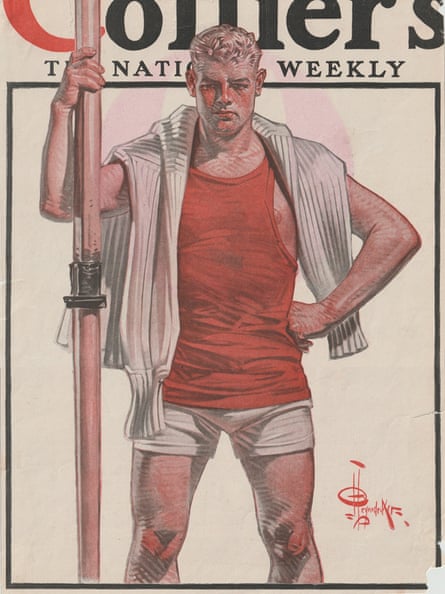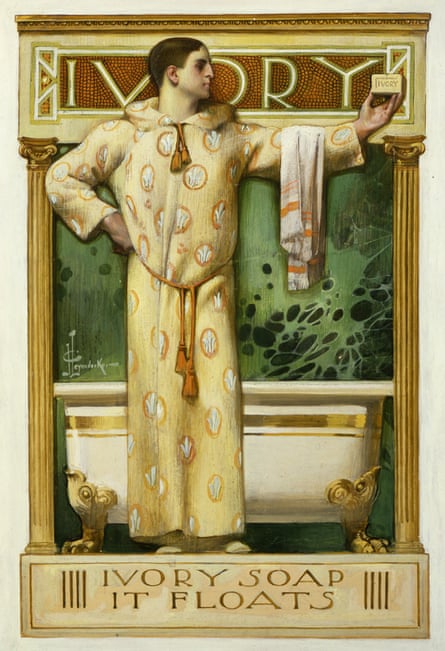“The ability of men to gaze at each other, which Leyendecker depicts, is very of his time. It’s very emblematic of what Bruce Weber does for Banana Republic, or advertising agencies for Abercromie & Fitch, or Calvin Klein underwear ads. That’s the modern-day interpretation of Leyendecker.”
Curator Donald Albrecht is telling me about the new exhibit at the New-York Historical Society that he guest-curated: Under Cover, which centers around the (not so) subtly homoerotic advertising images created by commercial artist JC Leyendecker. The show collects 19 of the artist’s original oil paintings. Rarely seen and fabulously intriguing, these works are delightful and provocative, a glimpse into both a flourishing, pre-Stonewall gay culture and the manic energy of 1920s high society New York.
Born in Germany in 1874, Leyendecker studied in Paris in his early 20s and built a name for himself in Chicago before eventually settling in New York City in 1902. He became renowned for his well-known advertising illustrations depicting the “Arrow Collar Man”, as well as for his many covers of the Saturday Evening Post – he made 322, just one less than the famed Norman Rockwell. “In contrast to Rockwell, who is very well known today, few people know about Leyendecker,” said Albrecht. “One hundred years ago, it would have been just the opposite: people would have known Leyendecker, and not Norman Rockwell.” Leyendecker was probably gay, living the bulk of his adulthood with his longtime model Charles A Beach
According to Albrecht, Leyendecker’s Gatsby-esque style reached its zenith in the 1920s, where the artist’s breezy, tongue-in-cheek paintings channeled the zeitgeist of a public drenched in flapper dresses and art deco stylings. “It’s representational, it’s populist, it’s commercial,” said Albrecht. “So someone like Andy Warhol would like someone like Leyendecker. Whereas someone like Jackson Pollock would probably not; he’d see it as derivative and trash. It’s not abstract, it’s not high art. He’s not a struggling artist.”

However, Leyendecker’s high-flying, commercially lucrative style was out by the 30s, when the gritty realities of the Depression began to bring Rockwell’s depictions of a more innocent, less complicated Americana into vogue. “During the Depression you have a kind of conservatism and a fear or experimentation and change. People sought the normative, and Leyendecker was not the normative.” As American art moved more solidly toward the high modernism of abstract expressionism, Leyendecker would fall further out of style, only rediscovered and reappreciated decades down the line.
But before then, for a stretch of about two decades, Leyendecker’s vision of a risque masculinity that blended the lines between macho and effeminacy had a freedom that was not seen again until much later in the 20th century. Whether it’s a bizarre 1928 Thanksgiving Day image of a gun-toting pilgrim and a football player staring meaningfully into one another’s eyes, or two well-dressed men suggestively hefting a golf club and lighting a pipe, Leyendecker’s images are absolutely arresting, while also pushing the viewer’s buttons. “It’s interesting to us that these images that seem to our eyes so homoerotic were acceptable in the 20s,” said Albrecht. “That he got away with this is really interesting. There’s one where a man seems to be aroused under a robe. It was an Ivory Soap ad, and Procter & Gamble wouldn’t publish that one, but everything else was publishable.”
Under Cover shows men doing things that they are not usually allowed to: strutting, carefully attending to the minute details of their outfit, exchanging intimate glances, delighting in their own embodiment and enjoying luxurious fabrics. It also often shows them at home within their own, male-dominated spaces, giving a sense of a glimpse into the forbidden. “He had access to those spaces,” said Albrecht. “As a gay man he knew that those spaces were very charged. There could be voyeurism, and there could be sexual activity.”
Leyendecker’s paintings have the carefully posed feeling of a catalog page, yet there is also a sense of subversion – it’s the kind of sly, provocative advertising that is usually associated with the 1990s and beyond, but Under Cover shows it to also be a product of the Roaring Twenties.

It is perhaps this combination of the loudly flamboyant and the subversive that gives these paintings their satisfying subtlety. Although never intended to be high art, Leyendecker’s work rises into the category of icon, giving form to a version of masculinity that has only been allowed to exist in certain times and places. “There are different definitions of masculinity and male behavior, and it’s mutable, it’s not fixed,” said Albrecht. “With Leyendecker, you’re never going to get what Harry Styles does. It’s never that overt. Instead, it’s nuanced and subtle.”
Under Cover seeks to bring museumgoers not just Leyendecker’s art but also the era it so perfectly fit into, including pieces that embody counter-narratives to Leyendecker’s very white, very Anglo universe. These include well-dressed African American men who showed off their style during the Harlem Renaissance, as well as juxtapositions from diverse aspects of the era’s gay culture, such as Broadway drag performances, stage plays starring women loving women, entertainers who pushed the lines of male femininity, and selections of art and poetry from gay creators.
“The challenge of the exhibition was Leyendecker was very white, very Aryan, very Christian, and we wanted to counteract that,” said Albrecht. “We look at the Harlem Renaissance. We also have masculinity in world war I, where we compare Leyendecker’s heroic soldiers to anti-war posters and magazines.”
Ultimately, Under Cover succeeds in both finding a new angle on the go-go 20s and complicating our picture of the emergence of the LGBT community into mainstream America. It reminds us that, even long before the second world war, gay and lesbian individuals did have spaces to live as themselves and celebrate who they were. “We wanted to reintroduce Leyendecker as a major aesthetic figure,” said Albrecht, “and to show the zeitgeist of sexuality at an earlier age than we largely think. It exactly mirrors Leyendecker’s heyday.”
-
Under Cover: JC Leyendecker and American Masculinity is on view at the New-York Historical Society until 13 August
"artist" - Google News
July 18, 2023 at 02:24AM
https://ift.tt/YrwfvM9
Under cover: the artist adding queerness to early American advertising - The Guardian
"artist" - Google News
https://ift.tt/VnZBgMl
Bagikan Berita Ini














0 Response to "Under cover: the artist adding queerness to early American advertising - The Guardian"
Post a Comment